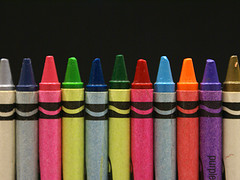
Flickr: laffy4k
A long time ago someone suggested I write about color words. I’ll be the first to admit that I’m not an artist and that most of my color knowledge comes from the Crayola Box of 64. But it’s true, color words are fascinating.
For example, vermillion comes from the Latin for “little worm”–there must be a species of bright red worm in Italy. (Vermicelli, the thin pasta, comes from the same root. And don’t forget about vermin.) Cerulean refers specifically to the blue of the sky. Magenta is named after a dye discovered near the town of Magenta, Italy. Cerise is French for cherry.
Orange is the color of an orange–the word hasn’t changed much since ancient times. In Sanskrit it was “naranga” and the modern Arabic word is “naranj.” What should have been “a naranj” became “an aranj” and thus the fruit and color we know today. Chartreuse, apparently, gets its name from a liqueur of the same name.
Then of course there’s lavender, coral, amethyst, rose, violet, thistle, chestnut, olive, lime, and dozens of other colors derived directly from nature.
John Ciardi in “How Does A Poem Mean?” (I am very distressed to find that this is out of print) argues that every word comes from something concrete. A daisy is a day’s eye, and so forth. His theory seems to hold up for the words discussed in this post, but I’d love to see what he’d do with Phthalo Blue.
0 Comments Leave a comment